How to make a bridal bouquet: sensory knowing in action
- Department of Visual Arts and Sloyd Education, Konstfack, University College of Arts, Crafts and Design, Stockholm, Sweden
This study explored the planning and making of a bridal bouquet in classroom interaction between a teacher and a student in a Swedish upper-secondary adult floristry education school. The purpose was to empirically reveal floristry disciplinary aesthetics. Aesthetics can be said to involve the exploration of sensory perception in general, entailing a focus on tacit sensory knowing. Methodologically, this study drew on the principles of ethnomethodology and (multimodal) conversation analysis to investigate video-recorded empirical data. The analysis included three separate sequences of interaction after the student requested the teacher’s attention. In the sequences, the student repeatedly provided answers to her own known-answer questions, and it remained her privilege to define what should be done and why as a consequence of the teacher’s authoritative guiding and gentle support. The results include examples of floristry disciplinary aesthetics in action when making a bridal bouquet, such as airiness and the role of outer shape. Moreover, in situ aesthetic judgement as part of sensory knowing is shown to be ample in the form of embodied actions, such as showing with the hands and communicating with facial expressions.
1 Introduction
This study explored the classroom interaction between a teacher and an upper-secondary student in Sweden, as displayed in the planning and making of a bridal bouquet, to reveal, in action, (floristry) disciplinary aesthetics – that is, the aesthetics bound to the specific school subject (Wickman et al., 2022). The starting point was an interest in the so-called “practical traditions of knowing” (Molander, 1996; Carlgren, 2015), combined with multimodal interaction analysis (Mondada, 2019, 2021b; Broth and Keevallik, 2020) of video-recorded empirical data. The data drew attention to in situ aesthetic judgement as part of sensory knowing (Emt, 2003), sensorium (Goodwin, 2018) and sensoriality (Mondada, 2021b). The latter (referring to sensory traits, regardless of chosen term or framework) contributes to the formation of any potentially stable (over time) specific aesthetic characteristics of the floristry school subject (and/or the education or craft).
Overall, aesthetics can be said to involve the exploration of sensory perception in general (Danius et al., 2012). In other words, the senses are at the core of aesthetics, and the ability to make aesthetic judgements is a consequence of the functioning of the same senses. These judgements entail an embodied sensation (Wallenstein, 2008) that, in floristry education, is related to becoming socialised into experiencing specific values and norms related to material and composition, through embodied practices of looking, touching and smelling (Biesta, 2021; Mondada, 2021b).
To varying degrees, every vocation has its own occupational aesthetic (Fine, 1992), acquired through the aforementioned process of socialisation (Wallenstein, 2008). In this way, the ability to make aesthetic judgements is also a form of vocational knowing applied in daily practice (Chan, 2015; Klope et al., 2022). This is the case in floristry (Gåfvels, 2016) and other traditional craft vocations, such as hairdressing (Andersson Gustafsson, 2002; Öhman, 2018; Klope, 2020), bookbinding (Tyson, 2014), textile craft (Ekström 2012), fashion design (Caruso et al., 2019) and goldsmithing (Musaeus, 2005). Since the means through which we perceive aesthetics are highly socialised (Grasseni, 2009), we must note that the content of aesthetics (in the form of more or less stable norms) is always subject to change over time, place and other factors (Bourriaud, 2002; Wallenstein, 2008), parallel to subject matter development in the wake of political reform (Todd, 2023). Todd (2023) emphasised that in an educational context, aesthetics is fundamentally about encountering, for example through pointing at something, with shifting borders:
The aesthetic dimension of educational encounters thus [does] not only pertain to whether or not they are creating some kind of art form, but rather[,] how the encounters can be seen as (artistic) formations of sensory experience (p. 8).
Again, simply put, the sensing part is the core. Likewise, the learning of a craft is both an emotional and embodied process (Dormer, 1994; Ekström, 2012; Groth, 2022). Furthermore, Dormer (1994) pointed out that expertise is acquired by “seeing mistakes [and] gaining the ability to discriminate” (p. 45) – in other words, by making use of sensory knowing. Mondada (2021b) described how “sensoriality” holds “a crucial role in decisive moments in the encounter” (p. 7), and Goodwin (2018) explained how sensorium in use can belong to – and be shared by – a community through co-operative action between individuals despite the sensorium being lodged in their separate bodies.
In this article, the implicit theoretical underpinning of the analysis is that the work process – depicted in the video recordings – is, in itself, a form of meaning-making process that contributes to the constitution of a social order (Insulander et al., 2021), which simultaneously forms the participants’ views of floristry knowing and process, including of disciplinary aesthetics. To convey the mechanism behind this form of social ordering, the concept of authoritative guiding (Meek, 2005) is used to explain how teaching and learning go hand in hand in the (current) classroom setting:
A knower can sense and grow in her ability to sense an authority candidate’s connectedness both to [the] known and to [the] knower. In other words, we build our authority-sensing skill. We sense in-touchness, […] care and expertise (p. 44).
Furthermore, Meek (2005) compared authoritative guiding to a global positioning system, emphasising that the person being guided might be wrong about many things but still be able to learn due to the set-up. Meek made frequent and direct reference to Polanyi, who wrote, among other things, that it is through indwelling that a novice apprehends the master’s skills: “Chess players enter into a master’s thought by repeating the games he played” (Polanyi, 1966, p. 14). In line with this view of (tacit) sensory knowing, this article focuses on sensorial practices (Mondada, 2021b). These practices are understood to be revealed through the social organisation of the senses in classroom interaction (Gåfvels, 2016; Öhman, 2018). Considering the above points, the following research question was developed to guide the investigation reported in this article:
What aspects of disciplinary aesthetics are discernible in the interaction between teacher and student when making a bridal bouquet?
2 Materials and methods
The analysed data – 4 min and 51 s of video-recorded classroom activity – stemmed from a larger corpus of approximately 50 h recorded during two semesters in a Swedish upper-secondary adult floristry education school. The transcripts that are reported in the Results section are for three separate sequences from within a total time frame of less than 30 min. The bridal bouquet was a one-day (5 h) assignment.
At an overarching level, the data show common features in floristry education regarding how teaching is organised as a regular, ordinary and ongoing classroom activity, such as talk-in-interaction. This includes, but is not limited to, the teacher’s verbal suggestions regarding potential choices and how the student responds and continues the work on the bouquet, notably, in the form of action formation (Schegloff, 2007) and co-operative actions (Goodwin, 2018). However, the analysis starts by answering the following questions: What’s next? and Why that now? (Schegloff, 2007). These questions draw attention to moment-by-moment interaction. Moreover, we explore sensoriality in interaction (Mondada, 2021b) by asking how participants engage in sensorial experiences intersubjectively, collectively and socially. Another core aspect of the analysis is the extent to which adjacency pairs (Schegloff, 2007) reveal how the student accepts the teacher’s offer, along with what else is discernible in the (multimodal) interaction.
Furthermore, the above reasoning implies that this study draws on the principles of ethnomethodology and (multimodal) conversation analysis (EMCA; Garfinkel, 1967; Goodwin, 2001, 2018; Schegloff, 2007; Streeck et al., 2011; Broth and Keevallik, 2020; Mondada, 2021b). In this process (EMCA), non-language phenomena – such as flowers, the bouquet and gestures – have been deemed “worthy of analysis on their own terms” (Murphy, 2023, p. 455). Streeck (2009) defines gestures as communicative actions that are performed by the hands, emphasising how gestural understanding results from “coordinated embodied actions of people and their perspectives upon the material, real-world setting within which they interact” (p. 5).
When making transcripts, there are always “underlying theoretical assumptions” (Ochs, 1979, p. 45). In this article, these assumptions include an explicit interest in sensory and embodied knowing (Streeck et al., 2011; Mondada, 2021a). Moreover, it should be noted that the video recordings are the data, and the transcripts stand no chance of capturing all aspects of the interaction (Cekaite and Goodwin, 2021). The omission of the (original) Swedish language is motivated by an ambition to promote readability and hence, intelligibility. When it comes to the analytical process, it began with a selection of situations wherein the teacher and the student assessed the bridal bouquet, guided by the EMCA criterion of explicit participant orientation (towards the bridal bouquet, meaning the two participants were discussing ongoing work during the work process). Three separate sequences, when the teacher went to the student’s table, were chosen and analysed more deeply, and revealed sensoriality in action. The three separate sequences started from the student addressing a problem and went on to capture the ensuing dialogue and the (multimodal) exchange about the visual outcome.
Line drawings based on frame grabs, which are presented in the Results section, form part of the analysis, in line with the (multimodal) EMCA emphasis on non-language phenomena, in order to identify and convey what is not easily said in words. That is, the drawings included in this article are not mere illustrations. Rather, in the eye of the researcher, they pinpoint specific details seen in the frame grabs.
Video recordings of sensorial engagements as they happen make it possible to analyze these movements in detail, in the way they precisely unfold in time, and coordinate with other bodies, sensing together or accompanying, watching, and guiding sensing bodies […]. In this way, sensing moments acquire their intersubjective shared intelligibility for the participants to social interaction (Mondada, 2021b, p. 6).
As always, general ethical guidelines (Vetenskapsrådet, 2017) apply to research, wherein some issues deserve extra attention when there is an ethnographical starting point. In relation to the transcripts and line drawings that will be presented in the next section, efforts were made to ensure that recognition and/or identification of the participants would not be possible. These efforts included altering the physical appearance of the participants and slightly modifying their spoken language.
3 Results
The assignment given to the seven students in the class was to make a bridal bouquet. Their starting point was to choose a theme based on a famous work of art. The teacher distributed pictures of different paintings to the students, one picture for each student. In the case of the student in focus in this article, the work of art was the painting “Café Terrace at Night” (Terrasse du café le soir) of Vincent van Gogh, which he completed in 1888. The paper print size was approximately 30 × 40 cm. The formal instruction – printed on a single sheet of paper handed out to each student – was to plan one’s work according to (1) the “assignment”, (2) the “design process”, and (3) CLAS (colour, line, area and shape). This type of learning trajectory involves a high degree of uncertainty for the learner. It can be tackled with authoritative guiding (Meek, 2005).
The teacher explained that the work of art would hopefully inspire and give the student an idea as to what to base the student’s choice of material and technique on, as well as provide something against which the student can evaluate or measure the final floristic product. To explain the choice of method, the teacher added that a bride-to-be could say she wants the floral arrangement to convey the same feeling or atmosphere as a specific work of art (Figure 1).
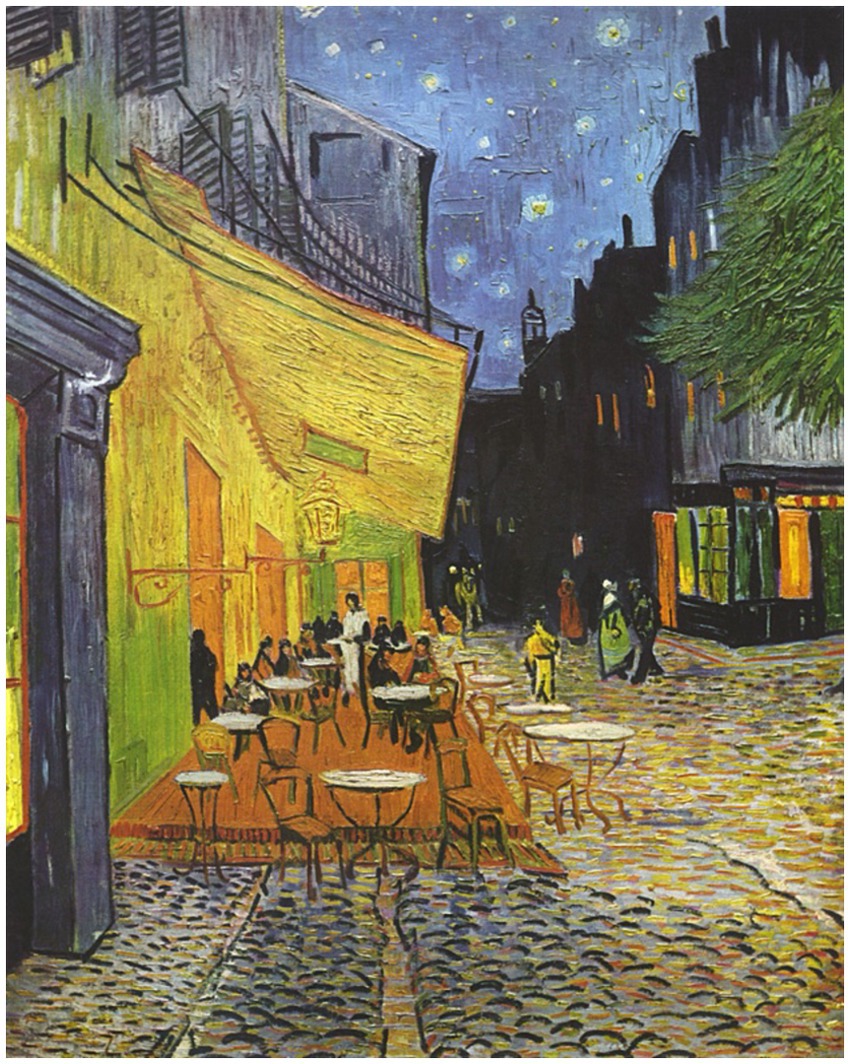
Figure 1. Reproduction of the painting “Café Terrace at Night” by Vincent van Gogh, given to the student for the assignment to plan and make a bridal bouquet.
3.1 Airiness and sprawling in Excerpt 1
The student has worked for 1 h on the bouquet and started placing flowers in the holder. She has already made choices regarding the material. The flowers to be used are standing in a bucket on the table. Then, the teacher comes by the student’s table for the first time and asks how her work is going.
EXCERPT 1 (2 min, 34 s)
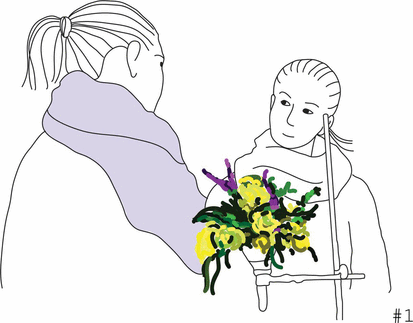
01 TEA: ^How is it going for you?
02 ^Looks at the student.
03 STU: ^I do not really know (.) I want to do one (.) that is round (.)
04 but a bit pointed.
05 ^Looks at the bouquet, cuts a branch and meets the teacher’s gaze.
06 TEA: Mmm=
07 STU: =but I do not know; I must have more air]#1
08 TEA: ]Mmm^ (3 sec) that could be
09 an idea.
10 ^Nods and looks at the bouquet, student and choice of flowers in
11 the bucket
12 (3 sec)
13 STU: Mmm
14 TEA: Mmm
15 (3 sec)
16 STU: Because I want^ still have some]
17 ^Points at a yellow rose in the middle of the bouquet
18 (3 sec)
19 TEA: ]Mmm^ that´s great
20 ^Looks at the bouquet from
21 different angles
22 STU: Ye:s. (2 sec) What had you done then?
23 TEA: But I had probably done so that I would not have had (.) eh, that
24 tight, because then, it is, you know: (.) otherwise, it will be (.)
25 you know, tight with a sprawl]
26 STU: ]Mmm
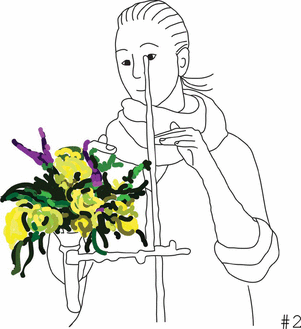
27 TEA: And then, the humidity (.) then, so (.) but it depends on what you
28 want to have as profile #2 (.) You want to have it round in this
29 shape]^
30 ^Shows a round form with the hands
31 STU: ]like a mushroom
32 TEA: Or do you think it should be flatter, kind of (.) and in
33 that case, you get, you kno::w^
34 ^Shows a flatter sloping line with the
35 hands and meets the student’s gaze
36 STU: Extend the flowers here ^(.) at, but I want to still that it
37 should be °a bit firm° (2 sec). It was kind of how I thought from
38 the start
39 ^Points at the bouquet.
40 TEA: Yes=
41 STU: =You should see that it is ^round-shaped (.) but then, I want to
42 still that it gets a bit sprawling=
43 ^Touches the flowers in the bouquet and
44 looks at the teacher; their gazes meet
45 TEA: =with volume^
46 ^nods
47 STU: =Ah yeah, well, exactly.
48 TEA: But what is it that should create the volume then?
49 STU: It is the foliage
50 TEA: Yes
51 STU: I have^ eucalyptus, pistage (.) these, I thought, but
52 materials, I do not know if they are too pointed that they do not
53 have so much volume but
54 ^Points at the different materials in the bucket and turns at
55 the same time as she holds the foliage in her hand
56 TEA: Mmm^=
57 ^Looks at the bouquet.
58 STU: =it becomes kind of (.) but I thought I should try not really
59 sprawling #3
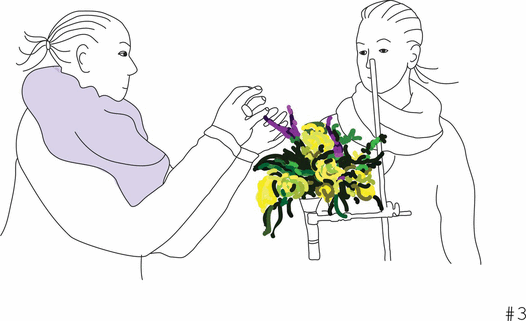
60 TEA: ^Mm, exactly () but if you cut, then, you have well nearly do maybe
61 do it #4 there so that you get this little nice top (#5)
62 ^Holds up a branch and takes away a bit of Thalaspi Green Bell
63 from the stem; makes eye contact
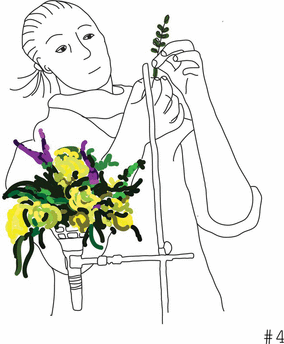
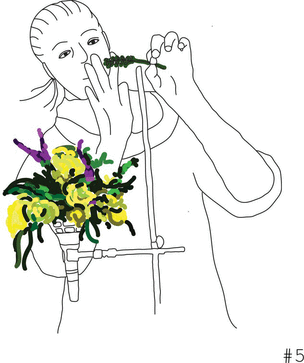
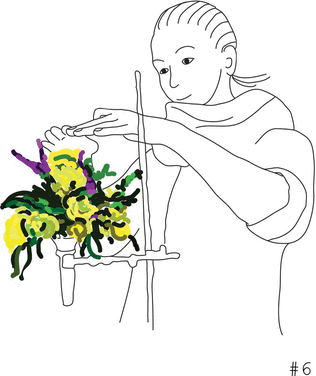
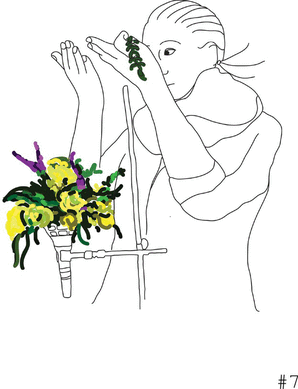
64 STU: =Ah, yeah, exactly.
65 TEA: Mmm, it can, you know, be ^nice to go down so here #6 you must look
66 so that you do not get that shape and go down instead this here lies
67 in the base (.) furthest down, and then you work upwards #7
68 ^Shows the placement of the Thalaspi Green
69 Bell in the bouquet; shows it with the hands at different angles
70 STU: Should I (.) must I (.) I do not want it to be really big
71 TEA: No
72 STU: I want to () I will try to come out^ with more foliage or
73 ^Shows with the hands how
74 foliage can be placed underneath the bouquet
75 TEA: Yes, because if you do not come out with more foliage here^(.) then
76 it will be ball-shaped, kind of
77 ^Shows
78 with the hands a movement up and down in a half-circle.
80 STU: No, but I do not want that, you know ^
81 TEA: ^ Turns the gaze and body and
82 asks the closest other pupil,”How is it going for you?”
Floristry disciplinary aesthetics in action are revealed in explicit (verbal) wording starting when the student says she wants her arrangement – when seen from above – to be “round” (line 3) but still “a bit pointed” (line 4), where “a bit pointed” indicates that she has not yet attained the desired aesthetic quality, while also providing an example of situated communication (Streeck, 2009). The teacher and student relatively quickly establish a “shared visual attention” (Goodwin, 2001, p. 157) as displayed in their pointing and gestures when talking about the bouquet’s airiness, as well as how the outer shape affects the visual expression regarding the same airiness (lines 23–25), in relation to the desired visual outcome “tight with a sprawl” (line 25) when seen either from above or in profile.
The overall visual expression the student (and teacher) are aiming for (in line with floristry disciplinary aesthetics) is an arrangement of a professional handicraft quality in which material and shape are harmonious insofar as the material chosen supports the desired expression. For example, a round-from-above bouquet consisting of only red roses has a calm expression and is very predictable from a florist’s perspective. Simply put, it is supposed to look a certain way. However, in the student’s bouquet, the round shape is supposed to be full of life in the form of material expressing airiness – in line with the perceived overall visual expression of the Van Gogh painting. Professional handicraft quality entails not only the choice of material but also the placement (not least technically). In this way, the available aesthetic options are interlinked, as displayed both regarding how the airiness is related to the outer shape (both from above and in profile) and how the tightness – or density – defines how sprawling (in terms of volume) the arrangement will be perceived.
When the teacher asks and gestures about whether the form of the bouquet should be flat or round (lines 29–30), it is a question of profile: “it depends on what you want to have as a profile” (line 27–28). The teacher is in favour of a sloping form, that is, a relatively flat form in relation to “round” (line 28). The student then responds by describing the later form “as a mushroom” (line 31). Meanwhile, the teacher displays the sloping form – in gestures – thereafter gazes meet and convey joint understanding and agreement.
The teacher then turns the conversation again, asking how the student will obtain volume (line 48) in the bouquet, thereby implicitly asking which material will be used. In other words, the choice of volume is directly linked to the choice of material (to be used), for example, “eucalyptus and pistage” (line 51), which is the student’s choice. When the student describes the chosen material, there is – again – an insecurity related to the talk about what overall visual expression the bouquet will have: on the one hand, airy and sprawling, but on the other hand, not too sprawling (lines 58–59, #3). When the student makes these remarks, gestures stress her “moments of understanding” (Streeck, 2009, p. 209).
In the final part of the excerpt, the teacher provides a solution for how the student can attain the desired visual expression “tight with a sprawl” (line 25) by working with the qualities of a specific type of foliage – Thalaspi Green Bell – to attain the desired airiness and volume. The gestures seen in (#5) together with “this little nice top” (line 61) communicate beauty and its “situated success” (Streeck, 2009, p. 204).
3.2 Theoretical concepts help in Excerpt 2
After working for 8 min with the bouquet – by adding flowers following the interaction in Excerpt 1 – the student calls the teacher to obtain further advice regarding how to group the flowers, without making the visual impression “too compact”.
EXCERPT 2 (1 min 5 s)
01 STU: If I will now group these without making them too compact (.)
02 how should I think then?
03 (3 sec)
04 TEA: You make sure not to put them so (.) tight^=
05 ^Looks at the student
06 and makes eye contact
07 STU: =^Should I still have some green in between but still yellow
08 groups groups yellow groups purple groups
09 ^Points with the hand where the different groups should be placed
10 TEA: Yes (.) exactly, and so you can, you know, think bigger, smaller,
11 smallest
12 STU: Yes
13 TEA: Mm^
14 ^Looks at the bouquet, then, at the student’s actions
15 STU: I have^, you know, some white twig roses. Where did that darned
16 thing go?
17 ^Looks at the bucket of flowers standing on the bench
18 TEA: And then, if you (.) want to avoid making it ^look
tight, then
19 ^Shows with the
20 hands a movement where the fingers meet
21 STU: Mmm
Omitted lines
25 TEA: If it is some area that is different=
26 STU: =Mmm, CLAS ((colour, line, area, shape))
27 TEA: Mmm (.) exactly. You need a ^#8 direction against this passive (.)
28 because here, there is no chance that it will be compact because
29 you have, you know, volume in between
30 ^Shows and points at the bouquet
31 about what is intended with the direction and where there is
32 volume with open hands
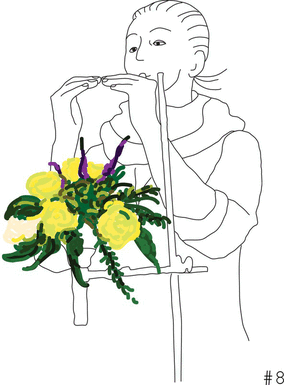
After working for 8 min with the bouquet – by adding flowers following the interaction in Excerpt 1 – the student calls the teacher to obtain further advice regarding how to group the flowers, this time without making the visual impression “too compact”.
The excerpt starts with a question about the placement of material in the bouquet, again revealing the student’s uncertainty about how to make the visual impression airy and not “too compact” (line 1). The wording “too compact” relates to the visual expression as well as to technical solutions used in the placement of material. The teacher emphasises “not to put them so […] tight” (line 4), thereby slightly correcting the student. The student becomes more precise in her suggestions, referring to specific groups of flowers by pointing (line 9). In turn, the teacher confirms the student’s overall idea, adding general advice regarding how to think about placing flowers in any bouquet: “bigger, smaller, smallest” (lines 10–11) to ensure harmonious transitions between materials, shapes, colours and textures.
Nonetheless, it should be noted that the teacher does not explicitly state what the student should do; rather, she reminds the student of a way of thinking (bigger, smaller, smallest) when grouping flowers – a disciplinary-aesthetic tool for decision making entailing achievement of a visual impression that is not “too compact” (line 1). The student’s ensuing description of her composition and how to go on, suggesting “twig roses” (line 15), signals her understanding of the instructions being given. Twig roses, as material, have the potential to enable a transition between different sizes of flowers, since the (twig) roses represent a contrast in size (of the capitulum) in relation to the already placed or grouped larger roses. Shortly afterwards, the teacher – again – returns to the student’s previously stated idea that the bouquet should not be “too compact” (line 1) by saying, “avoid (making) it (look) tight” (line 18), thereby repeating her previous (slight) correction (line 4) while demonstrating what she means with her fingertips, very precisely emphasising what she is aiming for (#8), as shown in the line drawing. With the help of clues provided in the teacher’s questions, the student says, “Mmm, CLAS” (line 26). This stands for Colour, Line, Area and Shape, and is a theoretical (disciplinary aesthetic) floristry tool when arranging flowers. In this context, it provides an answer to what the student needs to do to create more air in relation to the “passive” (line 27). In particular, the wording “this passive” (line 27) conveys how compactness removes the dynamic of the arrangement, with no room for sprawling volume.
The key takeaways from Excerpt 2 include how the dialogue shifts to a more theoretical (disciplinary aesthetic) level, seemingly allowing the student to use her learned repertoire of theoretical concepts, which is unveiled as she poses known-answer questions (Schegloff, 2007). In other words, the teacher guides (Meek, 2005) the student to rely more – over time – on her own assessments and judgement, aided by the pre-established knowing of these theoretical concepts; notably “passive” (line 27) and “CLAS” (line 26).
3.3 Solving the equation in Excerpt 3
Following the interaction in the previous excerpts, the student adds more material to the bouquet. About 20 min after the end of Excerpt 2, she again calls for the teacher’s attention. This time, the student has placed groups of different sizes, worked with foliage and created a round form. Still, something does not seem to add up, which she brings to the attention of the teacher by asking, “How should I solve the equation?” (line 1).
EXCERPT 3 (1 min 12 s)
01 STU: ^How should I solve (.) the equation?#9
02 ^Turns around the bouquet, looks at the bouquet, touches the
03 bottom side of the bouquet #9
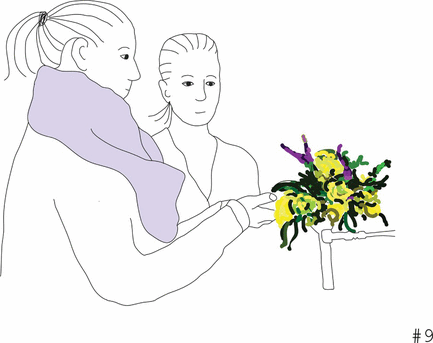
04 TEA: How do you think ^now? (.) Do you think that (.) What is the
05 problem?
06 ^Looks at the student; the student lifts the
07 base and looks at the bouquet
08 STU: It is a bit sprawling^ (.) It should be sprawling (.) That was the
09 thought, but I became a bit stressed because of it.
10 ^Continues to turn the bouquet
11 TEA: What is it^ that you need to calm down then?
12 ^Looks at the student
13 STU: Ye:s (.) I need, you know, because it is sprawling with fuzzy
14 material, so I need something shiny perhaps^ (.) darker
15 ^Touches a leaf of
16 eucalyptus
17 TEA: Yes. Do you have any suggestion?=
18 STU: =But I think first of the form(.) How shall I (.) because now it
19 is quite heavy.^=
20 ^Holds up the base of the bouquet. --->
21 TEA: =Yes
22 STU: I do not know if I can (2 sec) do some kind of arrangement
23 ->+
24 TEA: Yes (.) What you can do there is, you know (.) There, you have a
25 rose that you have inserted underneath that you are not allowed to
26 have^
27 ^Both look underneath the bouquet; the teacher points to where
28 the rose should not be placed #11-12
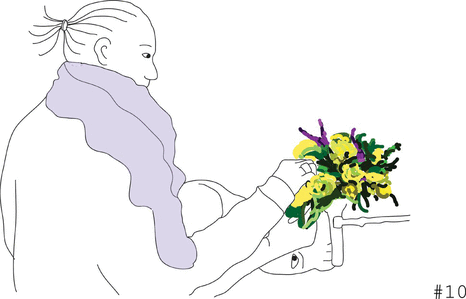
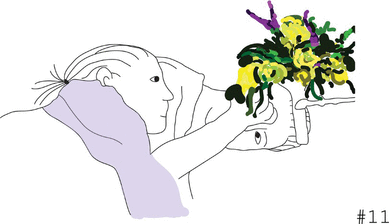
29 STU: Oh ()^
30 ^Looks underneath.
31 TEA: Here, you ^should, you know, lift=
32 ^Puts her hand underneath the bouquet
33 STU: =Mmm.
34 TEA: You see (.) If what you can do there is (1 sek) you know (.) If, for
35 example, you take (.) yes, some material and so that you tread it
36 and bend it up on the base so that you have the metal that lifts
37 so you can do that on the base^
38 ^Shows with her hands how the
39 technical solution gives an angle for lifting the bouquet
40 STU: Mmm
Following the interaction in the previous excerpts, the student adds more material, flowers and foliage to the bouquet. About 20 min after the end of Excerpt 2, she again calls the teacher’s attention. This time, the student has placed groups of different sizes and worked to create a feeling of airiness. Still, from her perspective, something does not seem to add up, which she brings to the attention of the teacher by asking, “How should I solve the equation?” (line 1).
While the student asks the teacher how “the equation” should be solved (line 1), she lifts the base of the bouquet (#9) and, through that movement, communicates that she is not happy. When the teacher asks, “What is the problem?” (lines 4–5), the student does not give a direct answer but, instead, alters the construction of the bouquet once more, by holding her hand beneath it, as shown in the first line drawing (#9). While holding the base of the bouquet, the student states that the bouquet is sprawling, but at the same time, she emphasises that it “should be sprawling” (line 8), adding that she is “a bit stressed because of it” (line 9). Then, the teacher asks what the student can do to “calm down” (line 11) the bouquet. The student suggests adding other materials to the composition, something “shiny” (line 14) and “darker” (line 14) to compensate for the “fuzzy” (line 13), thereby calming the visual expression. While the student provides these suggestions regarding her own work, she touches (lines 15–16) eucalyptus (a dusty pale grey foliage). The teacher asks for a more precise answer by asking for “suggestion” (line 17). At this point in time, the student’s attention changes back to the outer shape of the bouquet. She changes focus from the material in the bouquet to seeing the (overall) composition as “heavy” (line 19).
While saying so, she once again lifts the base of the bouquet to communicate a perceived lack of form. The student suggests – in an embedded question – that she can make “some kind of arrangement” (line 22) to alter the heavy expression in the outer shape of the bouquet. Then, to show or advise the student about how to go on, the teacher touches the base of the bouquet and lifts the outer shape, quickly looking underneath it and – as if in passing – verbally pointing out to the student that a rose is placed technically incorrectly (line 25). This occurs along with an active (multimodal) interplay in which the teacher and the student seem to reach an agreement about what the problem is. Both the teacher and the student change their (body) positions (lines 27–28) and look underneath the bouquet (#11) to get a change of scenery and a somewhat alternative sensorial experience of the bouquet. In the process, they attain a shared view of how the material is placed. The teacher shows, with her hand on the flowers, where the material needs to be lifted, thereby giving the bouquet a different closing angle and stabilising its form. Thus, the equation appears to be solved.
4 Discussion
It should be mentioned that the excerpts represent a complete lack of verbal reference to the interpretation of Van Gogh’s painting. Although the painting was the starting point of the assignment, it is not evident that the picture continues to be held in mind by the student or the teacher.
A review of the research question of this article – What aspects of disciplinary aesthetics are discernible in the interaction between teacher and student when making a bridal bouquet? – shows that, in addition to what they consist of, the excerpts provided clues regarding what occurs in the classroom when an upper-secondary student learns the craft. In the excerpts, flowers’ visuality is, in part, enacted as verbalisations, gestures and haptic corrections. The excerpts show how teaching floristry encompasses a variety of resources. How different units are arranged and how the teacher and students interact express the appropriate way forward regarding the specific composition at hand. This is based on how to speak during teaching about floristry and formal aesthetic content, such as volume, lines, colours, textures and forms, applied to different cut flowers. What surfaces is, to some extent, how there are specific aesthetic considerations in relation to different forms of cut flowers and foliage, essentially motivated by the (financial/visual) potential of the material, which is transformed in a process (in turn motivated by) generating (financial/visual) profit. In this context, there should ideally be maximum benefits and minimum waste. From this perspective, the concept of airiness is also of special interest. Working successfully with a high degree of airiness entails a high degree of craftsmanship, but ultimately also a higher degree of (financial/visual) profit since far less material is consumed in the process.
In this way, the excerpts also show how floristry knowledge entails knowing how to work with specific material compositions. Both how to place them and what works together – somewhat the most basic of floristry knowledge – is highly situated and not clearly easy to access without making floral arrangements in ongoing teaching activities. Although the sampled data concerns only 4 minutes, the excerpts can be said to be representative for the floristry educational process, both in terms of form and content of teaching.
Furthermore, throughout the excerpts, the teacher makes use of gestures (Streeck, 2009) to stress different aesthetic qualities, both in small parts, such as showing a piece of foliage, and when talking about the entire floral arrangement. Thus, primarily by using her hands, the teacher provides the student with access to a coordinated embodied understanding of the activity taking place. In this way – through interaction – the student is allowed to enter the sensorial experience of the teacher, very much like how Polanyi describes the indwelling through which a novice can gain access to the master’s skills. As stated at the outset of the introduction, what is at the core is sensorial practices, in line with how our senses are at the core of aesthetics, and the ability to make aesthetic judgements. Thus, regardless of the chosen term or framework, whether sensory knowing (Emt, 2003), sensorium (Goodwin, 2018) or sensoriality (Mondada, 2021b), in situ aesthetic judgement comes into focus in the moment-by-moment interactions in the three excerpts. The tacit and multimodal character of this in situ aesthetic judgement could also mean that the excerpts actually include references to the interpretation of Van Gogh’s painting, albeit not verbal and not easily discerned. In other words, the method used has potential and limitations; notably being limited by the fact that only 4 minutes of data is used to convey a learning trajectory. It should be emphasised that this all occurs in the interaction between student and teacher, which is the very reason some aspects might appear elusive, as the brief meeting of gazes can be a decisive final moment in a mutual exchange. Through this process, the student(s) is(are) socialised into an inner experience of the outer world in parallel to the teacher’s experiences. Over time, this leads to making aesthetic judgements that have much – or even everything – in common.
Finally, from the excerpts, the angle of the flowers in the holder was identified as both the problem and the solution. The sprawling or not of the bouquet was no longer an issue when it turned out that altering the form – the outer shape – remedied the situation and solved the so-called equation. At any given moment, there were multiple possible solutions for any given bouquet. As previously mentioned, available choices were interlinked, and any change made had an impact in more than one dimension. Against this backdrop, it is notable that the student continuously chose to add material to the bouquet. From the onset, removing material would have been a viable option. Working this other way around would have been a more complicated procedure for the relatively inexperienced floristry student in question. However, her choice to move forward and add material all the way limited the potential airiness that could be achieved. It should also be noted that this procedure of adding material limits the potential (financial/visual) profit of the material used, compared to what would have been the case if the bouquet was arranged by an experienced florist. In this way, the aesthetics conveyed in the excerpts of this article are also typical disciplinary aesthetics insofar as they are bound to the specific school subject (Wickman et al., 2022). In a high street florist setting, there would have been more air.
Data availability statement
The original contributions presented in the study are included in the article/supplementary material, further inquiries can be directed to the corresponding author.
Ethics statement
The studies were conducted in accordance with the local legislation and institutional requirements. The participants provided their written informed consent to participate in this study. Written informed consent was obtained from the individual(s) for the publication of any potentially identifiable images or data included in this article.
Author contributions
CG: Writing – original draft.
Funding
The author(s) declare financial support was received for the research, authorship, and/or publication of this article. The publication was funded by Konstfack, Stockholm.
Conflict of interest
The author declares that the research was conducted in the absence of any commercial or financial relationships that could be construed as a potential conflict of interest.
Publisher’s note
All claims expressed in this article are solely those of the authors and do not necessarily represent those of their affiliated organizations, or those of the publisher, the editors and the reviewers. Any product that may be evaluated in this article, or claim that may be made by its manufacturer, is not guaranteed or endorsed by the publisher.
References
Andersson Gustafsson, Gunilla. “Den inre teatern i lärandet: en studie om kunskapsväxande inom hantverk.” PhD diss., Kungliga tekniska högskolan, (2002).
Biesta, Gert. Konst som undervisning: konstundervisning “efter” Joseph Beuys. Rönninge: Arkeater, (2021).
Broth, Mathias., and Keevallik, Leelo. “Multimodal interaktionsanalys.”, Lund: Studentlitteratur. (2020).
Caruso, V., Cattaneo, A., Gurtner, J.-L., and Ainsworth, S. (2019). Professional vision in fashion design: practices and views of teachers and learners. Vocat. Learn. 12, 47–65. doi: 10.1007/s12186-018-09216-7
Cekaite, A., and Goodwin, M. H. (2021). Researcher participation, ethics, and cameras in the field. Soc. Interact. Video Based Stud. Hum. Soc. 4, 2–11. doi: 10.7146/si.v4i2.127215
Chan, S. (2015). Apprentices’ learning of occupationally informed practical judgment. Vocat. Learn. 8, 335–351. doi: 10.1007/s12186-015-9134-3
Danius, Sara., Sjöholm, Cecilia., and Wallenstein, Sven-Olov., eds., Aisthesis: Estetikens historia. D. 1. Stockholm: Thales, (2012).
Dormer, Peter. The art of the maker: skill and its meaning in art, craft and design. London: Thames and Hudson, (1994).
Ekström, Anna. “Instructional work in textile craft: Studies of interaction, embodiment and the making of objects.” PhD diss., Stockholms University, (2012).
Emt, Ewa Jeanette. “Baumgarten och den moderna estetetikens födelse” in Konsten och konstbegreppet. eds. Ingamaj Beck, Ewa Jeanette Emt, Anders Olsson, Tom Sandqvist & Magnus Winbladh (Kairos), (2003), 17–24.
Fine, G. A. (1992). The culture of production: aesthetic choices and constraints in culinary work. Am. J. Sociol. 97, 1268–1294. doi: 10.1086/229902
Gåfvels, Camilla. “Skolad blick på blommor: Formandet av yrkeskunnande i floristutbildning.” PhD diss, Stockholm: Stockholm University, (2016).
Goodwin, Charles. “Practices of seeing visual analysis: an Ethnomethodological approach.” In Handbook of visual analysis, edited by T. LeeuwenVan and C. Jewitt, 157–182. London: SAGE, (2001).
Grasseni, Cristina. Developing skill, developing vision: practices of locality at the foot of the Alps. New York: Berghahn Books, (2009).
Groth, C. (2022). “Video as a tool for knowing and telling in practice-led craft research” in Craft sciences. eds. T. Westerlund, C. Groth, and G. Almevik (Göteborg: Acta Universitatis Gothoburgensis), 48–85.
Insulander, Eva., Majlesi, Ali Reza., Rydell, Maria., and Åberg Svärdemo, Eva. “Multimodal analys av klassrumsinteraktion.” Stockholm: Liber, (2021).
Klope, Eva. “Förhandlingar av (yrkes)identitet och femininet i frisörutbildning.” PhD diss, Kalmar: Linnéuniversitetet, (2020).
Klope, Eva., and Gåfvels, Camilla. “Estetiska omdömen i skolförlagd frisörundervisning sedan 1970.” In Kvinnors yrkesutbildning i historisk belysning. Från förlaga till egen design, edited by Broberg, Åsa, Lindberg, Viveca, and Wärvik, Gun Britt, 188–207. Kunskapstraditioner och yrkeskunnande, (2022).
Meek, E. L. (2005). Learning to see: the role of authoritative guides in knowing. Tradit. Discov. 32, 38–50. doi: 10.5840/traddisc2005/200632226
Mondada, Lorenza. “Conventions for multimodal transcription.” (2019). Available at: https://www.lorenzamondada.net/_files/ugd/ba0dbb_986ddd4993a04a57acf20ea06e2b9a34.pdf.
Mondada, L. (2021a). Orchestrating multi-Sensoriality in tasting sessions: sensing bodies, normativity, and language. Symb. Interact. 44, 63–86. doi: 10.1002/symb.472
Mondada, Lorenza. Sensing in social interaction: the taste for cheese in gourmet shops. Cambridge: University Press, (2021b).
Murphy, K. M. (2023). “Multimodality” in A new companion to linguistic anthropology. eds. A. Duranti, R. George, and R. C. Riner, 443–460.
Musaeus, Peter. “Crafting persons. A sociocultural approach to recognition and apprenticeship learning.” PhD diss, Århus: Aarhus University, (2005).
Ochs, E. (1979). “Transcription as theory” in Developmental pragmatics. eds. E. Ochs and B. B. Schieffelin (New York: Academic Press), 43–72.
Öhman, A. (2018). Twist and shape: feedback practices within creative subject content of hairdressing education. Vocat. Learn. 11, 425–448. doi: 10.1007/s12186-017-9196-5
Polanyi, M. (1966). The logic of tacit inference. Philosophy 41, 1–18. doi: 10.1017/S0031819100066110
Schegloff, Emanuel A. Sequence organization in interaction. Cambridge: Cambridge University Press, (2007).
Streeck, J., Goodwin, C., and LeBaron, C. (2011). Embodied interaction: language and body in the material world. New York: Cambridge University Press.
Todd, Sharon. The touch of the present: Educational encounters, aesthetics, and the politics of the senses. Albany: State University of New York Press, (2023).
Tyson, R. (2014). Aesthetic Bildung in vocational education: the biographical case of bookbinding master Wolfgang B. And his apprenticeship. Vocat. Learn. 7, 345–364. doi: 10.1007/s12186-014-9120-1
Wallenstein, S.-O. (2008). Uppfinnandet av estetiken. Tidskrift för litteraturvetenskap 38, 61–74. doi: 10.54797/tfl.v38i3-4.12325
Keywords: disciplinary aesthetics, floristry, craft, sensory knowing, authoritative guiding
Citation: Gåfvels C (2024) How to make a bridal bouquet: sensory knowing in action. Front. Educ. 9:1316981. doi: 10.3389/feduc.2024.1316981
Edited by:
Steph Ainsworth, Manchester Metropolitan University, United KingdomReviewed by:
Robin Samuelsson, Uppsala University, SwedenRicardo Nemirovsky, Manchester Metropolitan University, United Kingdom
Copyright © 2024 Gåfvels. This is an open-access article distributed under the terms of the Creative Commons Attribution License (CC BY). The use, distribution or reproduction in other forums is permitted, provided the original author(s) and the copyright owner(s) are credited and that the original publication in this journal is cited, in accordance with accepted academic practice. No use, distribution or reproduction is permitted which does not comply with these terms.
*Correspondence: Camilla Gåfvels, camilla.gafvels@konstfack.se
 Camilla Gåfvels
Camilla Gåfvels